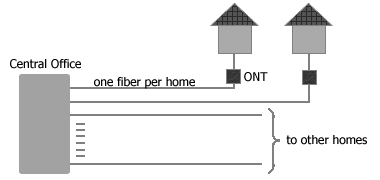Internet Access Guide : Fiber-To-The-Home (FTTH)

Picture: Home Run Fiber
A dedicated fiber from the CO to each subscriber home.
The ODN architecture is classified into Home Run Fiber
(point-to-point),
Active Star Ethernet (point-to-point), and Passive
Optical Network / PON (point-to-multipoint). In the Home Run Fiber, a dedicated fiber is
pulled to each subscriber from the CO so it is more expensive than
other architectures.

Picture: Active Star Ethernet
A dedicated fiber from a remote access node to each subscriber home.
In Active Star Ethernet, a dedicated fiber is extended to each subscriber from a remote access node which is connected
via optical Gigabit Ethernet network to the CO. This
architecture resembles typical DLC (Digital Loop Carrier)
architecture for delivering POTS/ISDN/DSL. In FTTH case, it is
sometimes called BLC (Broadband Loop Carrier).

Picture: Passive Optical Network (PON)
A passive splitter splits a fiber based on maximum split ratio and bandwidth demand.
And finally, PON is the most popular architecture because it
doesn't place active electronics in the optical distribution
network. Therefore it doesn't need electricity to power the
passive components and its maintenance is cheaper. But while Home
Run Fiber and Active Star Ethernet architectures can reach longer
distance of up to 80 km from the CO, PON has shorter reach of up
to 20 km.
|